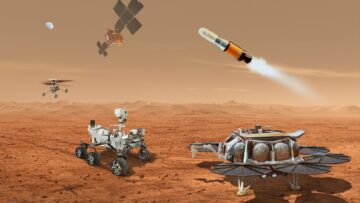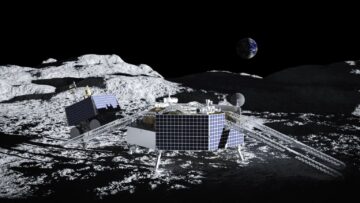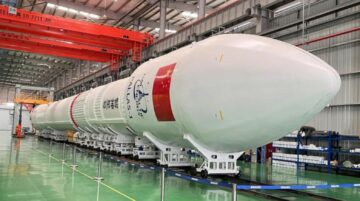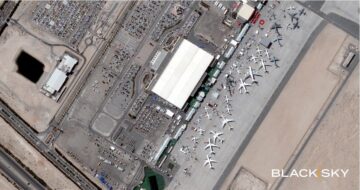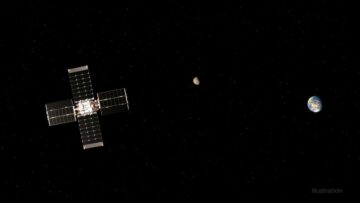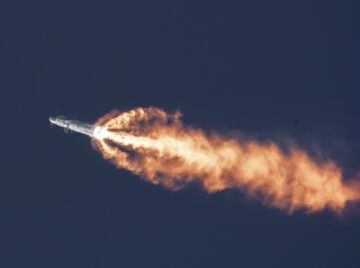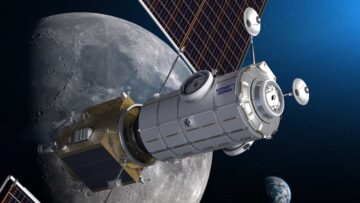ARLINGTON, Va. — The U.S. Space Force, despite being the youngest and smallest branch of the military, is emerging as a critical enabler for the Pentagon’s warfighting capabilities, a senior official said May 2.
What was once a complementary space architecture is today the central nervous system of joint operations, said Brig. Gen. Robert Hutt, director of plans and programs for the U.S. Space Force.
“It used to be that space capabilities were interesting, important, more so maybe to the commercial side, and maybe the warfighting side,” Hutt said in a presentation at a Space Force Association event. “And now we’ve gotten to a point where the Space Force is a critical part of the kill chains for the Department of Defense.”
“Kill chain” is a military term used to describe the sequential steps involved in successfully targeting and eliminating an enemy threat.
Hutt, who has overseen the preparation of the Space Force budget for the past three years, pointed out that since its inception in December 2019, the service has seen its budget nearly double to the current level of about $29 billion.
Some of this growth stemmed from transfers within the military as the Air Force relinquished space-related activities and personnel. But increases requested by the Biden administration and congressional add-ons also played a role.
The Space Force is about one-tenth the size of the Marine Corps. However, “a significant shift that we’ve seen over the last several years is that now the Space Force is a thing,” Hutt said. And that’s been reflected in the budget trend. Satellites and other systems operated by the Space Force “are of huge importance to the joint force,” he added. “There are really a lot of demand signals.”
The future budget outlook for the next five years is flat due to overall spending constraints, Hutt noted. This means the Space Force will have to make tough choices, especially as mission requirements continue to grow, he said.

Of the $29.4 billion requested for the Space Force for fiscal year 2025, the majority of the funding, or about $23 billion, goes towards research, development, and procurement of new technologies.
The Pentagon in its national defense strategy highlights space systems as the backbone of modern military operations, Hutt pointed out. That includes the Global Positioning System (GPS), satellites for communications and surveillance, early warning satellites detect ballistic missile launches, and weather satellites whose data informs operational planning.
Satcom is a ‘big foundational item’
A significant portion of the Space Force’s budget – approximately $5 billion in the fiscal year 2025 proposal – is allocated to satellite communications.
“There’s a large wedge for satellite communications, as you might expect,” Hutt said. “This is one of our big foundational items that we have to provide to the joint force.”
The importance of these communication satellites cannot be overstated, he said, particularly for deployed troops operating far from American soil. “Communications satellites are really the lifeline for our warfighters, especially the further we get away from the United States.”
- SEO Powered Content & PR Distribution. Get Amplified Today.
- PlatoData.Network Vertical Generative Ai. Empower Yourself. Access Here.
- PlatoAiStream. Web3 Intelligence. Knowledge Amplified. Access Here.
- PlatoESG. Carbon, CleanTech, Energy, Environment, Solar, Waste Management. Access Here.
- PlatoHealth. Biotech and Clinical Trials Intelligence. Access Here.
- Source: https://spacenews.com/space-force-flexes-muscle-as-pentagons-smallest-but-vital-branch/
- :has
- :is
- :where
- 1
- 10
- 11
- 12
- 13
- 17
- 19
- 2%
- 2019
- 2025
- 24
- 300
- 4
- 41
- 46
- 5
- 50
- 6
- a
- About
- activities
- added
- again
- AIR
- Air Force
- Alert
- allocated
- also
- American
- an
- and
- approximately
- architecture
- ARE
- AS
- Association
- At
- away
- Backbone
- BE
- been
- being
- biden
- Big
- Billion
- Branch
- budget
- but
- button
- by
- cannot
- capabilities
- central
- chains
- choices
- Close
- commercial
- Communication
- Communications
- complementary
- continue
- corps
- couldn
- critical
- Current
- data
- day
- December
- Defense
- Demand
- Department
- department of defense
- deployed
- describe
- Despite
- detect
- Development
- Director
- double
- due
- Early
- eliminating
- emerging
- enabler
- error
- especially
- Ether (ETH)
- Event
- expect
- false
- far
- Fiscal
- five
- flat
- For
- Force
- foundational
- from
- funding
- further
- future
- Gen
- get
- Global
- Goes
- gps
- Grow
- Growth
- Have
- he
- Hidden
- highlights
- However
- HTTPS
- huge
- importance
- important
- in
- inception
- includes
- Increases
- informs
- interesting
- involved
- items
- ITS
- joint
- journalist
- Kill
- large
- Last
- latest
- launches
- Level
- List
- Lot
- Majority
- make
- Marine
- max-width
- May..
- maybe
- means
- might
- Military
- Mission
- Modern
- more
- muscle
- nearly
- New
- New technologies
- Newsletter
- next
- noted
- now
- of
- official
- on
- once
- ONE
- operated
- operating
- operational
- Operations
- or
- Other
- our
- out
- Outlook
- over
- overall
- overstated
- page
- part
- particularly
- past
- pentagon
- Personnel
- planning
- plans
- plato
- Plato Data Intelligence
- PlatoData
- played
- please
- pm
- Point
- pop-up
- portion
- positioning
- preparation
- presentation
- process
- procurement
- Programs
- proposal
- provide
- publish
- RE
- really
- reflected
- requested
- Requirements
- research
- ROBERT
- Role
- s
- Said
- satellite
- satellites
- seen
- senior
- service
- several
- shift
- side
- signals
- significant
- since
- Size
- smallest
- So
- soil
- Space
- Space Force
- States
- Status
- stemmed
- Steps
- subscription
- Successfully
- surveillance
- system
- Systems
- T
- targeting
- Technologies
- term
- that
- The
- the joint
- There.
- These
- thing
- this
- threat
- three
- to
- today
- tough
- towards
- transfers
- Trend
- true
- try
- Tuesday
- u.s.
- U.S. Space Force
- United
- United States
- used
- veteran
- vital
- warning
- was
- we
- Weather
- were
- WHO
- whose
- will
- within
- year
- years
- you
- Youngest
- Your
- zephyrnet


